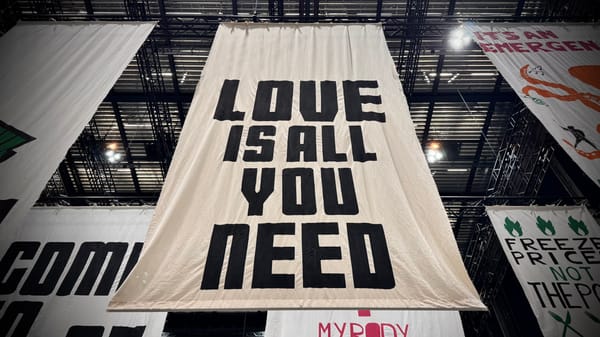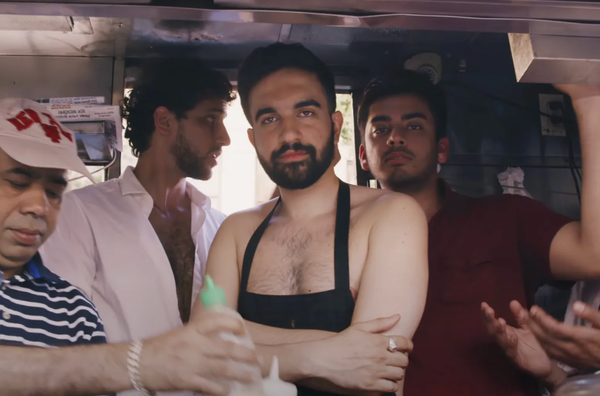Narratives need enacting, otherwise they’re just words
A theory for story in service to organising: get on the bike!

I have what is known as ‘resting perplexed face’. At last Friday’s event with democratic organising legend Marshall Ganz at Kairos, the host – UAL Storytelling Institute’s brilliant director Fran Panetta – was unfortunate to have my frowning visage in her eyeline, and was concerned the talk was not going well.
It was, of course, going very well. I apologised for projecting my perplexity. It was certainly not at Marshall’s wisdom, which was eloquent and distilled, and delivered with the kind of voice that you’d listen to reading out the phone book (remember those?). For me, Marshall’s key points were (paraphrasing):
- We learn best by doing (like riding a bike); get on, fall off, learn, keep going;
- Narrative is a crucial part of organising to make change; but narrative is not going to work on its own – you have to get others riding the bike too.
Both insights we at Absurd Intelligence agree with. Why then, was my boat race so off-putting (and not for the first time)?
One possible reason: Why do these points still need making in a room of social movement organisers, funders, writers, thinkers, policy and narrative advocacy proponents? Don’t we know our work well enough?
Doing the drills
Perhaps I need to relax my depressor supercilis and smile. It’s fine to repeat our movement’s precepts. Repetition of the basics is basic training in most fields. If you’re a yogi, you do sun salutations. If you’re an athlete, you do drills. If you’re a buddhist, you wash the dishes. If you’re a narrative advocate in the world of organising you tell stories, craft messaging, and run campaigns that are often built while riding the bike, and have an in-built ‘riding the bike’ mechanism for the people you are sharing the story with.
But, this ‘doing stuff’ bit is the hardest part. A lot of the public intellectuals in the field can write the words but, as smart as they are, don’t know how to get people to do stuff (Marshall does both). For those of us who have learnt some of how to do this, it’s still hard. Sometimes the athlete does not do her drills. Sometimes the narrative world wangs on about theory, forgetting that campaigns need practical enactment – from voting to physical protest to occupying space.
It also means the ‘doers’ often burn out. It’s not just avoiding doing the drills. Action is harder than writing. We have Action DOMS. The perpetual challenge is exhausting. Narrative proponents also know how to analyse the separation at the heart of social challenges and polarisation, while often being at the same time very consciously separated from embodied action.
To repeat: the enactment bit is the hardest part of social change. So what do we have people do!?
How change happens
One of my favourite examples is Veganuary: a month-long campaign to try something different. It has stabilizers in the first few weeks and a clear sense of doing different things each day. When you’ve enacted differently for 31 days, it critically gives people a cognitive distance from old behaviours.
I prefer the term cognitive distance to cognitive dissonance. It suggests spaciousness rather than pain or confusion. It was something I learnt firsthand going through a sleep retraining programme at the Glasgow Sleep Centre, basically CBT, to first shift behaviours in my sleep, and then to allow my cognitive processing to catch up with my new behaviour.
It is this distance from the story you used to ‘go by’ that is critical to give you space, to think differently about a new story about yourself you can ‘go by’ (and to notice the barrage of messaging around you that shaped how you enacted before).
This is basic social psychology. Mood and behaviour follow action, not the other way round. Get people doing stuff! (Sleeping better!) And get more people doing stuff so they build a new social common sense (sleep’s normal, don’t overthink it!). Make it okay to fall off the bike (have a bad night’s sleep). Make it easy to climb back on (😴).
That’s how change empirically happens – and we need change right now, don’t we?
Narrative Enactment
It’s hard to focus on enactment. But it’s right. This is the theory of narrative enactment that I’ve been working with for a decade or so now, and which helped me design successful campaigns (such as the 2023 “Animal Lovers” narrative of Animal Rising’s Grand National campaign, asking people to act on their values as ‘animal lovers’, resulting in positive social outcomes for animals).
It’s part of our work at Absurd Intelligence and the reason why we’re involved not just in producing new narratives, but grounding how the stories we need can lead to changes in behaviours – not just buying a better product, but altering our attitudes to how life is organised around us. It is changes to behaviours that most likely lead to shifting our common sense narratives of who we are – for example, as good neighbours – and how we can take the fate of our country into our own hands, not feel helpless, or abandoned by Westminster.
That is: if we agree that stories shape our world, then they don’t do so by magic. It happens because people enact them, ‘go by’ them to make sense of their actions. (A caveat: there are two ways this change happens: people doing stuff, and seeing others do stuff. The first is more powerful but the second also works. The UCL Climate Action Unit call these ‘action possibilities’.)
Either way though, it begins by getting people doing stuff!
Doing stuff!
For me, the theory is best laid out in Hans Hansen’s book Narrative Change, where a case study of transforming the institutional racism of the Texas legal system through offering new narratives is explained in detail. The basis is this:
We run on scripts. At the individual and societal level, we run on stories (some of which are heuristics) that make it easy for us to navigate our worlds – common sense that we ‘go by’ so we don’t have to stop and think about every tiny thing.
These scripts, stories, or narratives, can be relatively shallow or deeply embedded in our lives and as national or cultural myths (“boys don’t cry” is a pernicious one). Society pressures us into following scripts that are often very bad for us. Greedy corporations know this and use advertising and marketing to keep us enacting stories that are bad for us (e.g. the Yorkie bar Man-Time Competition).
For change to happen, we need to do three things:
- Show people the old stories they ‘go by’ no longer work for them (bike’s broke);
- Give them new stories they can try out (get on the new bike);
- Help them repeat the new story through enactment (ride the bike) while also showing them that everyone else is enacting them (also riding the bike).
This is the change action loop of narrative enactment. A good campaign draws attention to the existing scenario where old narratives no longer make sense, then offers new narratives for how to act, behave, or interpret those new scenarios, and new opportunities for action that run on those new narrative scripts.
What organisers are aiming for is to shift people out of the unconscious enactment of existing scripts (“boys don’t cry”) or the conscious enactment of existing scripts (where people prefer the comfort of the unhealthy behaviour because it suits their needs; read Andrew Tate’s emails to young men), and into narrative construction. Then, the enactment attempt of that newly constructed story is narrative abduction – on repeat.
There’s a few key things to make this work:
- Be one step and only one step ahead of the existing script. The reassembly of existing material (“boys cry all the time, mostly at the football!”) works, whereas something alien to the existing story (“boys are emotional beings with deeply egoic sentimental attachments to other boys’ feelings”) probably won’t work;
- Repetition of the message and enactment (Veganuary’s meal plans);
- Safety nets and support for when the unconscious becomes conscious (the “oh fuck I’ve been getting it wrong” moment, often accompanied by the Big Reverser, shame).
Narrative and social change
Narrative enactment practice is wrapped up in social change theory that, for me at least, has its best expression in the work of Erica Chenoweth and Damon Centola. Here are some primers on their work:
This empirical social science concerns tipping points for switching social norms:
- For Chenoweth there is a “3.5% rule” that has been widely discussed and acted upon, suggesting no regime can resist this 3.5% of the population challenging its control; however, diving into their work more fully there’s another 20% of the population who need to be seen supporting the 3.5%, for change to happen;
- This tallies with Centola’s finding that you need approx. 25% of the population to spread an idea – the tipping point – so it becomes common sense behaviour;
- And much of this owes debts to Rosabeth Moss Kanter’s 1970s research on structural empowerment (and many others along the way).
There is a lot more to dive into here. And much of the narrative work being done now, especially in the aftermath of the reality of Trump’s election, is practicing narrative not as theory but in the service to organising while holding the grief of what is being taken/lost (h/t Paddy from Internarratives for the link).
It’s this that was steeling my facial muscles while listening to Marshall Ganz. The challenge ahead – get people doing stuff! – is the hard part of narrative leadership.
It is why one of the key things Absurd Intelligence is doing is convening people. We’re doing more of that on Sept 11th for The Fate of Britain Convention, a chance for those doing the work to come together and change the world. If you’re interested in this rolling-up-the-sleeves approach to narrative and are happy falling off bikes, please get in touch with us here:
If you do come – and please come! – don’t be offended if my face is in a grump.
Elsewhere in Absurdity...
I forgot this last week, so here’s a couple of weeks’ worth of updates on what we’ve been doing at Absurd Intelligence.
- A few weeks ago Clive co-wrote this on design and environmental activism;
- Last week Maddy and Sophie had a three-day visit to Birkenhead and Liverpool to recce for The Fête of Britain and the forthcoming event at Rough Trade (12th June);
- Also last week Charlie went to see Riefenstahl, a masterful exploration of the difference between what-you-say and what-you-do. As easy to read as a comment on today’s climate self-delusion as it is the rise of the right. Thankfully Charlie cheered himself up by also seeing the Mekons at the 100 Club. 45 years into their career, their mix of punk, country, folk and politics is the most joyous advert for embodied action;
- Also last week, Alanna and Clare went to Kairos to hear Nafeez Ahmed discuss ideas from his book Alt Reich;
- On Sunday Clare went to the launch of Defashion x Degrowth: the Handbook of Fashion Degrowth at the Islington Climate Centre;
- On Tuesday and Wednesday it was Charlie’s turn to recce for The Fête of Britain, this time to Doncaster and Middlesbrough;
- On Tuesday Alex met with volunteers at Toothill, Swindon, to plan for communicating with the neighbours about getting the community centre open;
- On Wednesday Daze was all over the country in her role as Bee Ambassador for World Bee Day and the #greatbritishbeechallenge;
- Also on Wednesday Alex was part of the panel on populism and Reform at the Hard Art pub night, alongside Joe Mulhall from Hope Not Hate, Phoebe Clay from Unchecked UK, and Jacqui Howard from MobLab;
FINALLY... we’ve been watching our friend the amazing Ian Bruce on his 5-day live stream “We Need to Talk About Elon” (click on Ian’s LIVE face).
And if reading all that has made you hungry:






